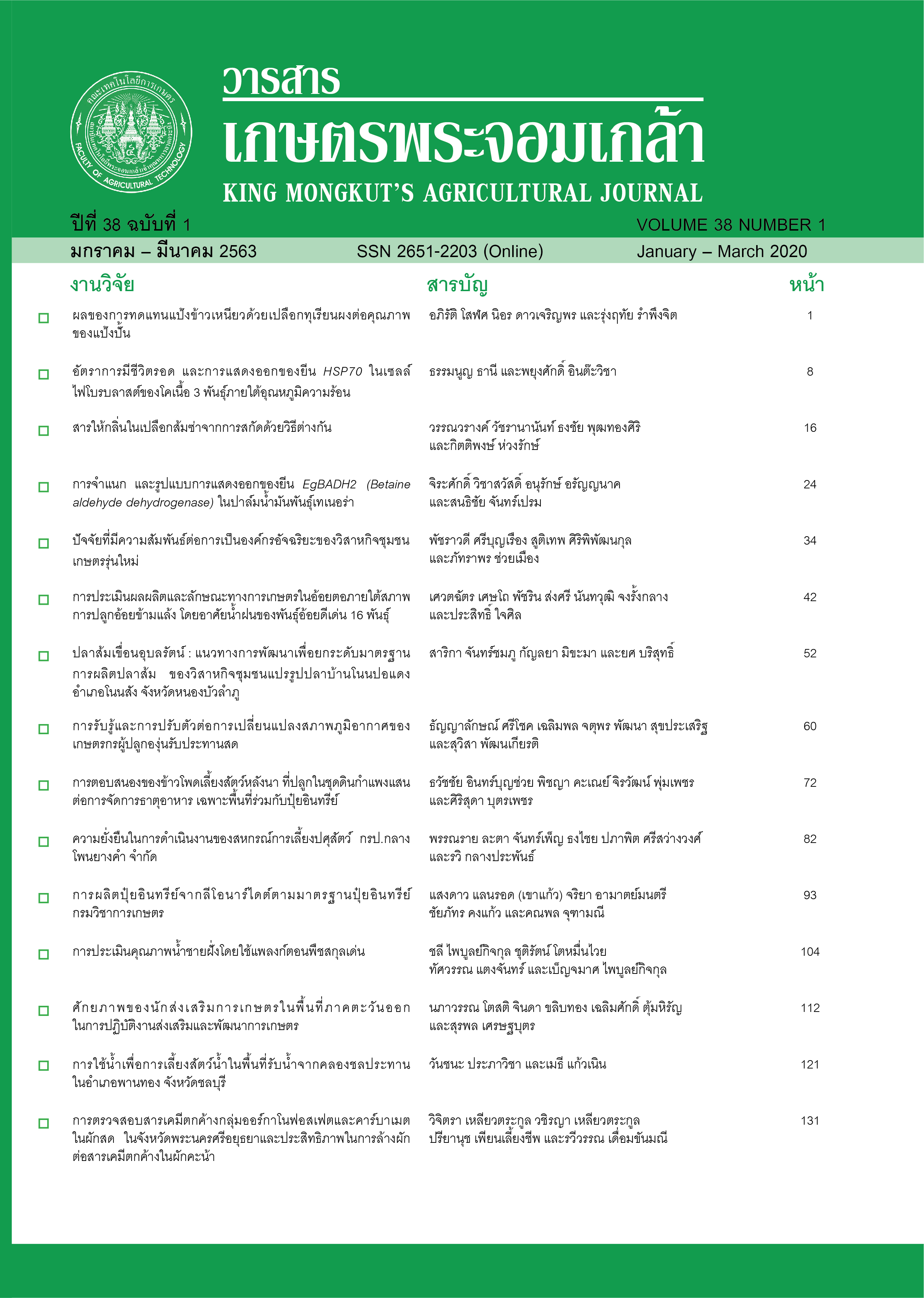อัตราการมีชีวิตรอด และการแสดงออกของยีน HSP70 ในเซลล์ไฟโบรบลาสต์ของโคเนื้อ 3 พันธุ์ภายใต้อุณหภูมิความร้อน
Main Article Content
บทคัดย่อ
ยีนฮีทช็อคโปรตีน 70 (heat shock protein, HSP70) มีบทบาทสำคัญในการปรับตัว การอยู่รอด และการตอบสนองต่อความร้อนของเซลล์โคเนื้อ การศึกษานี้มีจุดประสงค์เพื่อทราบถึงอัตราการมีชีวิตรอด และการแสดงออกของ HSP70
ในเซลล์ไฟโบรบลาสต์จากโคลูกผสมขาวลำพูน-แองกัส ขาวลำพูน-ชาร์โรเล่ส์ และขาวลำพูน ภายใต้อุณหภูมิความร้อน
เซลล์ไฟโบรบลาสตร์ถูกเก็บจากใบหู จากนั้นนำมาเพาะเลี้ยงในตู้บ่ม 5% CO2 ที่อุณหภูมิ 38.5 องศาเซลเซียส การศึกษาที่ 1 อัตราการมีชีวิตรอดของเซลล์ไฟโบรบลาสต์ได้รับความร้อนที่อุณหภูมิ 42 องศาเซลเซียส เป็นระยะเวลา 24 และ 48 ชั่วโมง พบว่าอัตราการมีชีวิตรอดของเซลล์ของกลุ่มโคพื้นเมืองขาวลำพูนสูงกว่า (ร้อยละ 97.73±0.16 และ 93.33±1.90) กลุ่มโคลูกผสมขาวลำพูน-แองกัส (ร้อยละ 96.36±0.35 และ 88.88±1.31) และกลุ่มโคลูกผสมขาวลำพูน-ชาร์โรเล่ส์ (ร้อยละ 96.70±0.44 และ 89.16±1.37) อย่างมีนัยสำคัญทางสถิติ (p<0.05) การศึกษาที่ 2 การแสดงออกของยีน HSP70 ด้วยวิธี
RT-PCR ในเซลล์ไฟโบรบลาสต์หลังจากฮีทช็อคที่อุณหภูมิ 42 องศาเซลเซียส เป็นระยะเวลา 6, 12 และ 24 ชั่วโมง พบว่า เซลล์ในทุกกลุ่มมีการแสดงออกของยีน HSP70 แสดงให้เห็นถึงกลไกการตอบสนองต่อความร้อนระดับเซลล์ของทั้งโคพื้นเมืองและ
โคลูกผสม สรุปได้ว่า เซลล์ไฟโบรบลาสต์ของโคพื้นเมืองขาวลำพูนเมื่อได้รับความร้อนที่อุณหภูมิ 42 องศาเซลเซียสมีอัตราการ
มีชีวิตรอดของเซลล์สูงกว่าโคลูกผสม และเซลล์ไฟโบรบลาสต์ของโคทุกกลุ่มมีการแสดงออกของยีน HSP70 เมื่อได้รับความร้อนที่อุณหภูมิ 42 องศาเซลเซียส แสดงถึงกลไกการทำงานระดับเซลล์ของโคเนื้อที่สามารถปรับตัวเข้ากับสภาพในเขตร้อนชื้นของประเทศไทยได้
Article Details
วารสารเกษตรพระจอมเกล้า
เอกสารอ้างอิง
ในเซลล์เม็ดเลือดขาวของโคพื้นเมืองไทยต่อสภาพอากาศในรอบวัน. แก่นเกษตร 40 (2): 377-380.
เรืองยศ พิลาจันทร์ และวันชัย อินทิแสง. 2559. สมรรถภาพการผลิตของโคลูกผสมพื้นเมือง×โลน์ไลน์แองกัสระดับสายเลือดต่าง ๆ
เมื่อได้รับฟางข้าวและกากแป้งมันสำปะหลังหมัก. แก่นเกษตร. 44 (1): 425-431.
Abdian, N., Dehkordi, P. G., Chaleshtori, M. H., Arjenaki, M. G., Doosti, A., and Amiri, B. 2015. Comparison of human dermal fibroblasts (HDFs) growth rate in culture media supplemented with or without basic fibroblast growth factor (bFGF).
Cell Tissue Bank 16: 487-495.
Agha, E., Kosanovic, D., Schermuly, R. T., and Bellusci, S. 2016. Role of fibroblast growth factors in organ regeneration and repair. Semin Cell Dev Biol. 53: 76-84.
Basirico, L., Morera, P., Primi, V., Lacetera, N., Nardone, A., and Bernabucci, U. 2011. Cellular thermotolerance is associated with heat shock protein 70.1 genetic polymorphisms in Holstein lactating cows. Cell Stress Chaperones 16: 441-448.
Bhanuprakash, V., Singh, U., Sengar, G., Sajjanar, B., Bhusan, B., Raja, T. V., Alex, R., et al. 2016. Differential effect of thermal stress on HSP70 expression, nitric oxide production and cell proliferation among native and crossbred dairy cattle. J. Therm Biol. 59: 18-25.
Changqing, L., Guo, Y., Taofeng, L., Xiangchen, L., Weijun, G., and Yuihui, M. 2014. Establishment and genetic characteristics analysis of in vitro culture a fibroblast cell line derived from Wuzhishan miniature pig. Cryobiology 68: 281-287.
Collier, R. J., Dahl, G. E., and VanBaale, M. J. 2006. Major advances associated with environmental effects on dairy cattle.
J. Dairy Sci. 89: 1244-1253.
Csermely, P., Schnaider, T., Soti, C., Prohaszka, Z., and Nardai, G. 1998. The 90-kDa molecular chaperone family: structure, function and clinical applications a comprehensive review. Pharmacol Therapeut 79: 129-168.
Deb, R., Sajjanar, B., Singh, U., Kumar, S., Singh, R., Sengar G., and Sharma, A. 2014. Effect of heat stress on the expression profile of Hsp90 among Sahiwal (Bos indicus) and Frieswal (Bos indicus × Bos taurus) breed of cattle: A comparative study. Gene 536: 435-440.
Dobson, H., and Smith, R. F. 2000. What is stress, and how does it affect reproduction. Anim Reprod Sci. 60-61: 743-752.
Fanny, D. 2004. The sculpturing role of fibroblast-like cells in morphogenesis. Perspect Biol. Med. 47: 339-356.
Fujita, J. 1999. Cold shock response in mammalian cells. J. Mol Microb Biotech. 1: 243-255.
Intawicha, P., Ou, Y. W., Lo, N. W., Zhang, S. C., Chen, Y. Z., Lin, T. A., Su, H. L., et al. 2009. Characterization of embryonic stem cell lines derived from New Zealand white rabbit embryos. Cloning Stem Cells 11: 27-38.
Kregel, K. C. 2002. Heat shock proteins: modifying factors in physiological stress responses and acquired thermotolerance.
J. Appl Physiol. 92: 2177-2186.
Lee, J. W., Li, H., Wu, H. Y., Liu, S. S., and Shen, P. C. 2016. Improved cellular thermotolerance in cloned Holstein cattle derived with cytoplasts from a thermotolerant breed. Theriogenology 85: 709-717.
Ravagnolo, O., Misztal, I., and Hoogenboom, G. 2000. Genetic component of heat stress in dairy cattle, development of heat index function. J. Dairy Sci. 83: 2120-2125.
Sartori, R., Haughian, J. M., Shaver, R. D., Rosa, G. J., and Wiltbank, M. C. 2004. Comparison of ovarian function and circulating steroids in estrous cycles of Holstein heifers and lactating cows. J. Dairy Sci. 87: 905-920.
Schuldiner, M., Yanuka, O., Eldor, J. I., Melton, D. A., and Benvenisty, N. 2000. Effects of eight growth factors on the differentiation of cells derived from human embryonic stem cells. PNAS 97: 11307-11312.
Singh, A. K., Upadhyay, R. C., Malakar, D., Kumar, S., and Singh, S. V. 2014. Effect of thermal stress on HSP70 expression in dermal fibroblast of zebu (Tharparkar) and crossbred (Karan-Fries) cattle. J. Therm Biol. 43: 46-53.
Wegner, K., Lambertz, C., Das, G., Reiner, G., and Gauly, M. 2014. Climatic effects on sow fertility and piglet survival under influence of a moderate climate. Animal 8: 1526-1533.
WU, H. Y., Peng, S. Y., Li, H., Lee, J. W., Kesorn, P., Wu, H. H., Ju, J. C., and Shen, P. C. 2017. Ear fibroblast derived from Taiwan yellow cattle are more heat resistant than those from Holstein cattle. J. Therm Biol. 66: 56-62.


